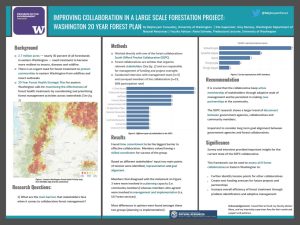Improving Collaboration In A Large Scale Forestation Project: Washington 20 Year Forest Plan
Due to projected increase in wildfires, droughts as well as insect outbreaks, forest health and resiliency is of urgent concern for communities in Eastern Washington. The Washington 20 Year Strategic Forest Health plan was created to increase the scale and pace of treatment of 2.7 million acres of forest land in Eastern Washington. However, with more than 33 agencies involved in this effort, a framework to analyze the effectiveness of stakeholders is needed. The purpose of this study was to assess different stakeholders’ involvement in a large scale governmental forestation project and identify gaps between stakeholders to increase collaboration amongst different entities. I worked directly with one of the forest collaboratives – South Gifford Pinchot Collaborative (SGPC). Forest collaboratives organize relevant stakeholders and are responsible management of funding and project oversight . I had informational interviews with the management team of the SGPC and sent out a survey to the members of the collaborative (22 responses, 66% participation rate). Based on different stakeholders’ input, two main points of tension were identified; representation and goal alignment. The issue of time commitment was consistent throughout the responses. Moreover, many of the members oppose off forest planning projects whereas the 20 Year Forest Plan calls for an ‘all-lands’ approach. Overall, the survey and interview provided important context for the current state of the collaborative which is significant because the same method can be used for all 8 forest collaboratives in Eastern Washington to identify tension points, gauge stakeholders’ perception and create new funding avenues for future projects and partnerships.
